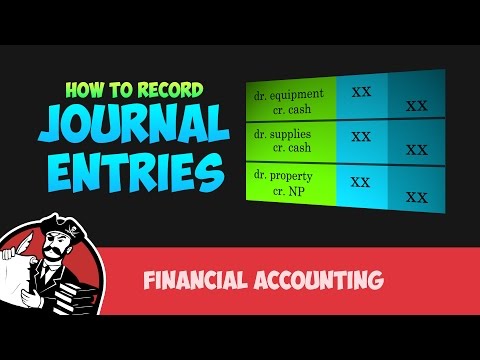3.6: Journal Entries
- Page ID
- 26186
Double-entry bookkeeping, in accounting, is a system of bookkeeping so named because every entry to an account requires a corresponding and opposite entry to a different account. This lesson will cover how to create journal entries from business transactions. Journal entries are the way we capture the activity of our business.
When a business transaction requires a journal entry, we must follow these rules:
- The entry must have at least 2 accounts with 1 DEBIT amount and at least 1 CREDIT amount.
- The DEBITS are listed first and then the CREDITS.
- The DEBIT amounts will always equal the CREDIT amounts.
For another example, let’s look at the transaction analysis we did in the previous chapter for Metro Courier (click Transaction analysis):
1. The owner invested $30,000 cash in the corporation. We analyzed this transaction by increasing both cash (an asset) and common stock (an equity) for $30,000. We learned you increase an asset with a DEBIT and increase an equity with a CREDIT. The journal entry would look like this:
| Debit | Credit | |
| Cash | 30,000 | |
| Common Stock | 30,000 |
2. Purchased $5,500 of equipment with cash. We analyzed this transaction as increasing the asset Equipment and decreasing the asset Cash. To increase an asset, we debit and to decrease an asset, use credit. This journal entry would be:
| Debit | Credit | |
| Equipment | 5,500 | |
| Cash | 5,500 |
3. Purchased a new truck for $8,500 cash. We analyzed this transaction as increasing the asset Truck and decreasing the asset Cash. To increase an asset, we debit and to decrease an asset, use credit. This journal entry would be:
| Debit | Credit | |
| Truck | 8,500 | |
| Cash | 8,500 |
4. Purchased $500 in supplies on account. We analyzed this transaction as increasing the asset Supplies and the liability Accounts Payable. To increase an asset, we debit and to increase a liability, use credit. This journal entry would be:
| Debit | Credit | |
| Supplies | 500 | |
| Accounts Payable | 500 |
5. Paid $300 for supplies previously purchased. Since we previously purchased the supplies and are not buying any new ones, we analyzed this to decrease the liability accounts payable and the asset cash. To decrease a liability, use debit and to decrease and asset, use debit.
| Debit | Credit | |
| Accounts Payable | 300 | |
| Cash | 300 |
6. Paid February and March Rent in advance for $1,800. When we pay for an expense in advance, it is an asset. We want to increase the asset Prepaid Rent and decrease Cash. To increase an asset, we debit and to decrease an asset, use credit.
| Debit | Credit | |
| Prepaid Rent | 1,800 | |
| Cash | 1,800 |
7. Performed work for customers and received $50,000 cash. We analyzed this transaction to increase the asset cash and increase the revenue Service Revenue. To increase an asset, use debit and to increase a revenue, use credit.
| Debit | Credit | |
| Cash | 50,000 | |
| Services Revenue | 50,000 |
8. Performed work for customers and billed them $10,000. We analyzed this transaction to increase the asset accounts receivable (since we have not gotten paid but will receive it later) and increase revenue. To increase an asset, use debit and to increase a revenue, use credit.
| Debit | Credit | |
| Accounts Receivable | 10,000 | |
| Services Revenue | 10,000 |
9. Received $5,000 from customers from work previously billed. We analyzed this transaction to increase cash since we are receiving cash and we want to decrease accounts receivable since we are receiving money from customers who we billed previously and not new work we are doing. To increase an asset, we debit and to decrease an asset, use credit.
| Debit | Credit | |
| Cash | 5,000 | |
| Accounts Receivable | 5,000 |
10. Paid office salaries $900. We analyzed this transaction to increase salaries expense and decrease cash since we paid cash. To increase an expense, we debit and to decrease an asset, use credit.
| Debit | Credit | |
| Salaries Expense | 900 | |
| Cash | 900 |
11. Paid utility bill $1,200. We analyzed this transaction to increase utilities expense and decrease cash since we paid cash. To increase an expense, we debit and to decrease an asset, use credit.
| Debit | Credit | |
| Utilities Expense | 1,200 | |
| Cash | 1,200 |
All the journal entries illustrated so far have involved one debit and one credit; these journal entries are called simple journal entries. Many business transactions, however, affect more than two accounts. The journal entry for these transactions involves more than one debit and/or credit. Such journal entries are called compound journal entries.
If you would like to watch another video about journal entries, click Journal Entries.
How do we prepare financial statements from these journal entries? The journal entries just allowed us to capture the activity of the business. In the next section we will organize the information to make it easier to prepare financial statements.
- Accounting Principles: A Business Perspective. Authored by: James Don Edwards, University of Georgia & Roger H. Hermanson, Georgia State University. Provided by: Endeavour International Corporation. Project: The Global Text Project . License: CC BY: Attribution
- Journal Entries. Authored by: Debra Porter. Located at: youtu.be/KILj-JWglDM. License: All Rights Reserved. License Terms: Standard YouTube License
- Journal Entries and The Accounting Cycle. Authored by: Note Pirate. Located at: youtu.be/ji2b6kNTbUM. License: All Rights Reserved. License Terms: Standard YouTube License


